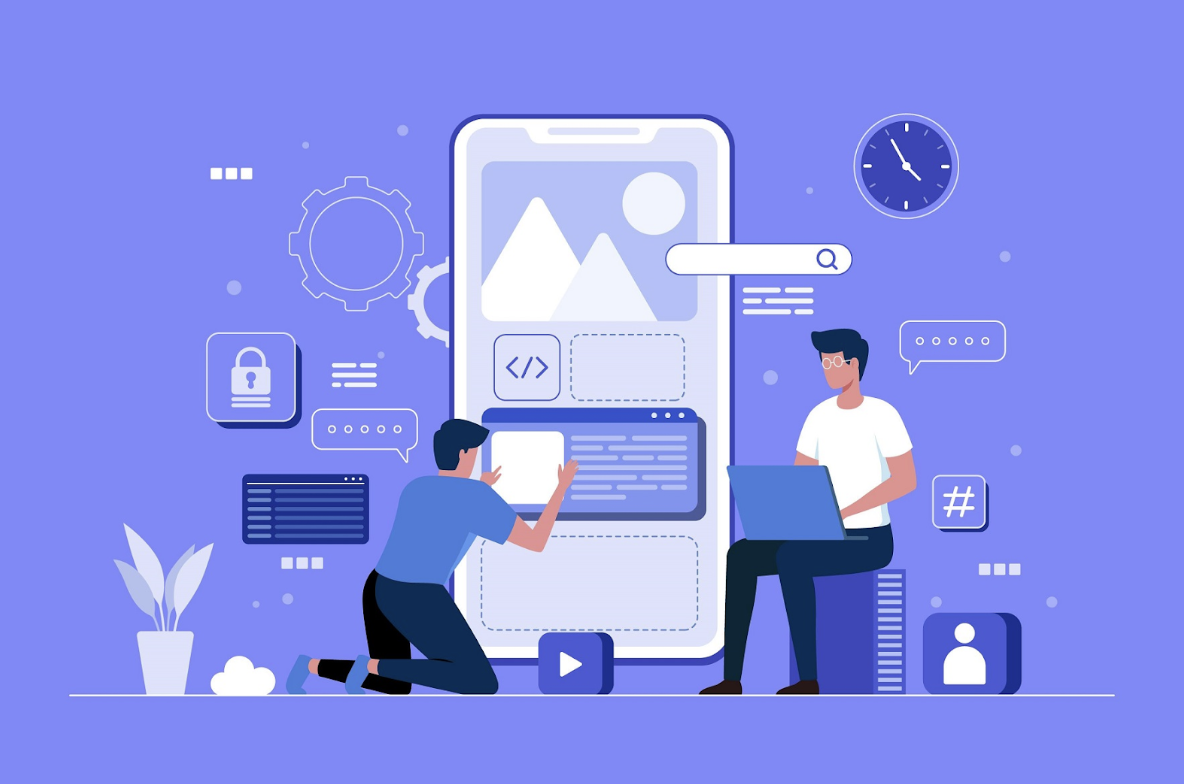
- 05th Aug '25
- Sell SaaS
- 8 minutes read
Enterprise software development services for large companies
Walk into any big corporation, and you’ll notice something quickly, there’s an invisible machine running everything. It’s not just the people or the products. It’s the systems they use every single day. Finance, supply chain, HR, customer support… all held together by software that most outsiders never see.
But here’s the catch. For every polished app the public interacts with, there’s often a jumble of outdated platforms and mismatched tools behind the scenes. A sales team might track leads in one system, accounting in another, and the two don’t even “talk.” That’s why more companies quietly turn to enterprise software development services, not to add something shiny, but to make the entire structure work like one coherent organism.
Because when a corporation grows beyond a certain point, patchwork solutions start to show their cracks. And no business with global ambitions wants to build its future on cracks.
What enterprise software actually means
The term itself sounds a little vague, almost corporate-speak. But in reality, it’s pretty simple. Enterprise software is any application built to run a company’s most important operations at scale. We’re talking about ERP platforms, supply chain management tools, customer relationship systems, internal HR hubs, even complex analytics dashboards.
These aren`t the sort of equipment you down load with one click on and begin the usage of in an afternoon. They`re designed to address hundreds of thousands of transactions, coordinate heaps of employees, and preserve departments that hardly ever engage at the identical page.
The tricky part? No two enterprises run exactly the same way. Which means no “out of the box” software can possibly cover every need.
Why generic tools hit their limit
A startup can survive on plug-and-play apps. A marketing team can run campaigns on a SaaS tool, sales can track leads in a spreadsheet, and no one minds.
But scale that to a company operating in 15 countries? Suddenly, the cracks turn into craters.
-
Data silos pile up. Sales, finance, HR, logistics, all generating data that doesn’t line up.
-
Legacy systems hang on. Some departments cling to decades-old software “because it still works,” even if it barely integrates with modern tech.
-
Operations get tangled. Different time zones, currencies, compliance rules, complexity multiplies.
-
Scaling becomes painful. When user traffic triples overnight, can the system handle it? Or does it grind to a halt?
Relying on generic tools at that level is like trying to run a city on camping generators. It works, sort of, until the lights go out.


What enterprise software development services actually bring
Here’s where things get interesting. Hiring a team to provide enterprise software development services isn’t about tossing them a checklist and waiting for an app to appear. It’s a partnership that reshapes how the entire business operates.
A good provider doesn’t just write code, they learn how the company breathes. They map workflows, identify bottlenecks, and figure out where outdated processes are costing time and money. Then they build solutions that don’t just “fit in” but actively improve how people work.
This usually involves:
-
In-depth discovery. Talking to stakeholders, analyzing pain points, and understanding what the business actually needs, not just what’s written in the RFP.
-
Architecture design. Creating a system that won’t collapse the moment the company grows or shifts strategy.
-
Development and integration. Writing the code and connecting it with the tools already in use, so nothing breaks mid-process.
-
Testing at scale. Because one glitch in enterprise software can mean thousands of failed transactions in a single hour.
-
Ongoing support. The project doesn’t end when the software launches. It evolves, just like the business does.
The bigger picture, it’s not just about “efficiency”
Yes, these systems streamline processes. But that’s only part of the story.
When a multinational producer subsequently receives real-time visibility into its deliver chain, selections show up faster. When a healthcare company integrates affected person information throughout dozens of clinics, care improves. When financial reporting stops relying on manual spreadsheets, accuracy skyrockets.
Good enterprise software doesn’t just save money, it changes how a company feels. Employees stop fighting clunky systems. Customers notice smoother service. Leadership gets insights they didn’t have before.
The risks and challenges
Of course, none of this is simple. Enterprise-level development is a different world compared to building a consumer app.
-
The stakes are enormous. A small glitch in a public-facing app might annoy users. A glitch in enterprise software can stall entire departments.
-
Security can’t be optional. Sensitive data, financial, legal, personal, is everywhere. A breach isn’t just embarrassing. It’s catastrophic.
-
Customization takes time. There’s no “install and go.” Everything needs to be tailored to the organization’s reality.
-
Budgets and timelines are serious. Projects often stretch over months, even years, and the investment isn’t small.
This is why not every development agency should take on enterprise work. It requires more than coding skill. It demands an understanding of how massive organizations function, and what happens if their software stops.


Trends changing enterprise software right now
Enterprise software doesn’t sit still. The way companies build and use these systems is shifting, fast.
Cloud-first is becoming the default
Not long ago, enterprise systems lived on servers in some dusty corner of the office. Now, the cloud is winning. Why? Faster deployment, easier updates, and the ability to scale without waiting for new hardware. It’s not without challenges, security, compliance, and migration hurdles are real, but the shift is undeniable.
AI is quietly taking over the boring parts
From predicting demand surges to automating support tickets, AI isn’t just hype. In enterprise software, it’s creeping into the background, doing the tasks humans don’t need to waste time on. It doesn’t replace teams, it makes them sharper.
User experience finally matters
For years, enterprise software had a reputation for being ugly and painful. Employees dreaded using it. That’s changing. Companies now expect their internal tools to feel as smooth as consumer apps. Because if staff hate the system, they’ll avoid it.
Systems are becoming modular
Instead of one giant “all-in-one” platform, more enterprises are building systems from connected modules. APIs are the glue, making it easy to swap out or add components as needs change.
Why custom builds usually win
Sure, there are pre-made enterprise tools on the market. Some are solid. Many work for a while. But eventually, they bump into limits.
Custom enterprise software:
-
Fits exactly how the company operates, no awkward workarounds.
-
Integrates cleanly with existing and future tools.
-
Can grow and evolve without forcing the business to start from scratch.
-
Creates a real competitive edge. If your internal systems do something competitors can’t, that matters.
It’s like the difference between buying a suit off the rack and having one tailored perfectly. Both cover you, but one just… fits better.
How to pick the right partner
Choosing the right team for enterprise software development services isn’t just another procurement line item. It’s a decision that can shape how a company operates for the next decade.
The right partner will have:
-
Proven experience. They’ve done this for large organizations before. They understand the complexity.
-
Clear communication. No endless jargon, just honest updates and expectations.
-
Collaboration built in. They listen as much as they advise.
-
Long-term commitment. Because launching is just the beginning.


Avoiding the common traps
Even with great partners, mistakes happen. The most common?
-
Designing for today, not tomorrow. Companies grow. Markets shift. Software that can’t adapt will choke.
-
Forgetting the end users. If employees hate using the tool, adoption dies.
-
Underestimating rollout pain. Training, migration, change management, they’re not afterthoughts.
What happens when enterprise software works
When it all comes together, the results aren’t just “better IT.” They’re company-wide.
Leaders get real-time insights instead of waiting weeks for reports.
Employees stop battling outdated tools and actually focus on their jobs.
Customers get faster service and stick around longer.
The company can expand, new markets, new products, new regions, without constant panic.
Wrapping it up
Enterprise software isn’t just code sitting on a server. It’s the framework that holds an organization together. And for the biggest companies, it’s more than infrastructure, it’s the difference between barely managing and truly leading.
Choosing the right enterprise software development services partner isn’t a quick decision, but it’s one of the smartest moves a company can make. Done right, the software doesn’t just support the business. It becomes the business, flexible, powerful, and ready for whatever the future throws its way.
 Create your own software
Create your own software



